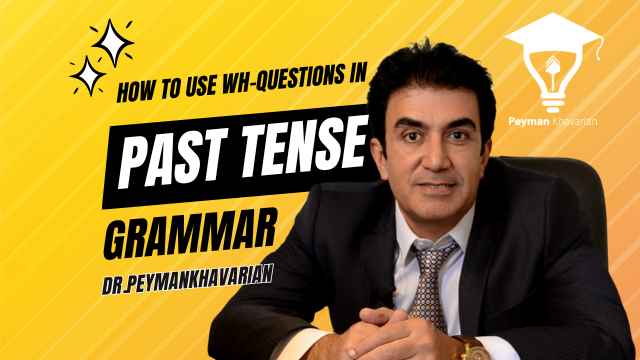Forming ‘Wh’ Questions in the Past Tense ساخت ‘Wh’ سوالات در زمان گذشته

Forming ‘Wh’ Questions in the Past Tense
‘Wh’ questions are an integral part of English language communication. They are used to gather information and are typically formed with ‘wh’ words such as ‘what’, ‘where’, ‘when’, ‘why’, ‘who’, ‘which’, and ‘how’. When these questions are framed in the past tense, they allow us to inquire about events, actions, or conditions that have already occurred.
Structure of ‘Wh’ Questions in the Past Tense
The general structure of a ‘wh’ question in the past tense is as follows:
'Wh' word + auxiliary verb (did) + subject + base form of the verb + rest of the sentence?
For example, “Where did you go yesterday?” or “What did she eat for breakfast?”
In these examples, ‘did’ is the auxiliary verb used to indicate the past tense, followed by the subject (‘you’, ‘she’), and then the base form of the main verb (‘go’, ‘eat’).
Exceptions in the Structure
However, there are exceptions to this rule. When the verb ‘to be’ or modal verbs such as ‘could’, ‘should’, ‘would’, etc., are used, the structure changes to:
'Wh' word + verb ('was', 'were', 'could', etc.) + subject + rest of the sentence?
For example, “Who was at the party?” or “Why were they laughing?”
Importance of ‘Wh’ Questions in the Past Tense
‘Wh’ questions in the past tense are essential for various forms of communication, such as storytelling, reporting, and conversational dialogue. They allow us to extract detailed information about past events and understand situations more clearly.
Conclusion
Mastering the formation of ‘wh’ questions in the past tense is crucial for effective communication in English. It allows for precise inquiries about past events, enhancing our understanding and interpretation of situations. As with any aspect of language learning, practice is key to becoming proficient in forming these questions.
ساخت ‘Wh’ سوالات در زمان گذشته
سوالات ‘Wh’ بخش جدایی ناپذیری از ارتباط زبان انگلیسی هستند. این سوالات برای جمع آوری اطلاعات استفاده می شوند و معمولاً با کلمات ‘wh’ مانند ‘what’، ‘where’، ‘when’، ‘why’، ‘who’، ‘which’ و ‘how’ شکل می گیرند. وقتی این سوالات در زمان گذشته قرار می گیرند، به ما اجازه می دهند در مورد رویدادها، اعمال یا شرایطی که قبلاً رخ داده است، سوال کنیم.
ساختار ‘Wh’ سوالات در زمان گذشته
ساختار کلی یک سوال ‘wh’ در زمان گذشته به شرح زیر است:
'Wh' word + فعل کمکی (did) + فاعل + شکل اصلی فعل + بقیه جمله؟
برای مثال، “Where did you go yesterday?” یا “What did she eat for breakfast?”
در این مثال ها، ‘did’ فعل کمکی است که برای نشان دادن زمان گذشته استفاده می شود، سپس فاعل (‘you’، ‘she’)، و سپس شکل اصلی فعل اصلی (‘go’، ‘eat’).
استثناها در ساختار
با این حال، استثناهایی در این قاعده وجود دارد. وقتی فعل ‘to be’ یا فعل های modal مانند ‘could’، ‘should’، ‘would’ و غیره استفاده می شوند، ساختار تغییر می کند به:
'Wh' word + فعل ('was'، 'were'، 'could' و غیره) + فاعل + بقیه جمله؟
برای مثال، “Who was at the party?” یا “Why were they laughing?”
اهمیت ‘Wh’ سوالات در زمان گذشته
سوالات ‘Wh’ در زمان گذشته برای انواع مختلف ارتباطات مانند داستان سرایی، گزارشگری و گفتگوی مکالمه ای ضروری هستند. آنها به ما اجازه می دهند تا اطلاعات دقیق در مورد رویدادهای گذشته را استخراج کنیم و به فهم بهتر وضعیت ها کمک کنیم.
نتیجه گیری
تسلط بر ساخت سوالات ‘wh’ در زمان گذشته برای ارتباطات موثر در زبان انگلیسی حیاتی است. این امکان را می دهد تا در مورد رویدادهای گذشته سوالات دقیقی را مطرح کنیم، که به درک و تفسیر ما از وضعیت ها کمک می کند. مانند هر جنبه ای از یادگیری زبان، تمرین کلیدی برای تبدیل شدن به ماهر در ساخت این سوالات است.
- Where did you buy this book? (کجا این کتاب را خریداری کردید؟)
- What did they say about the meeting? (آنها در مورد جلسه چه گفتند؟)
- When did you finish your homework? (کی تکلیفتان را تمام کردید؟)
- Why did she leave the party early? (چرا او زود از مهمانی رفت؟)
- Who did you see at the concert? (چه کسی را در کنسرت دیدید؟)
- How did you solve this problem? (چگونه این مشکل را حل کردید؟)







دیدگاهتان را بنویسید